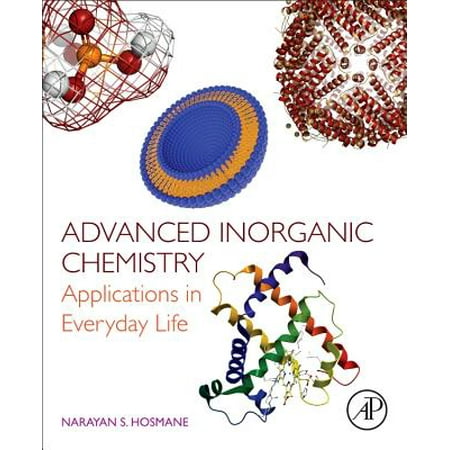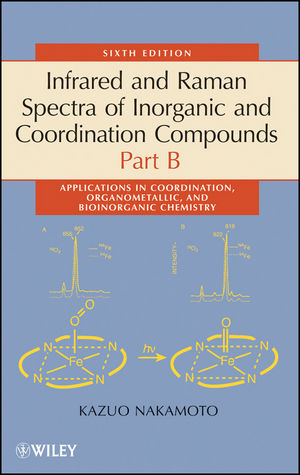Inorganic Chemistry Applications
- Applications of Inorganic Chemistry It is applied in the field of medicine and also in healthcare facilities. The most common application is the use of common salt or the compound Sodium hydroxide in our daily. Baking soda is used in the preparation of cakes and other foodstuffs. Many inorganic.
- NMR has played an important role in the analysis of inorganic molecules for a long time. Over 80% of all nuclei have at least one NMR active isotope and many of these compounds are used in materials, catalysts and also as active centers in bio-inorganic molecules.
- Inorganic Chemistry Definition Examples & Applications. Inorganic chemistry is one of the branches of chemistry that deals with inorganic substances. These substances can be both metallic and non-metallic. They are exclusively called inorganic because they are devoid of carbon. Chemically they are formed by ionic or covalent bonds.
- Inorganic Chemistry Applications
- Organic Chemistry And Inorganic Chemistry
- Inorganic Chemistry Applications Online
- Inorganic Chemistry Applications Examples
- Applications Of Inorganic Chemistry
- Inorganic Chemistry Test
- Physical Chemistry
- Advanced Inorganic Chemistry Applications In Everyday Life
Secure Checkout
Personal information is secured with SSL technology.Introduction to Inorganic Chemistry, Atomic Structure, and Bonding. Study humanity's discovery of the atomic structures, familiarize yourself with representations of molecules, visualize molecular geometry, and recognize common types of intermolecular attractions. Investigate the interactions between atoms as well as the instability and decay of radioactive elements.
Free Shipping
Free global shippingNo minimum order.
Description
Advanced Inorganic Chemistry: Applications in Everyday Life connects key topics on the subject with actual experiences in nature and everyday life. Differing from other foundational texts with this emphasis on applications and examples, the text uniquely begins with a focus on the shapes (geometry) dictating intermolecular forces of attractions, leading to reactivity between molecules of different shapes.
From this foundation, the text explores more advanced topics, such as: Ligands and Ligand Substitution Processes with an emphasis on Square-Planar Substitution and Octahedral Substitution Reactions in Inorganic Chemistry and Transition Metal Complexes, with a particular focus on Crystal-Field and Ligand-Field Theories, Electronic States and Spectra and Organometallic, Bioinorganic Compounds, including Carboranes and Metallacarboranes and their applications in Catalysis, Medicine and Pollution Control.
Throughout the book, illustrative examples bring inorganic chemistry to life. For instance, biochemists and students will be interested in how coordination chemistry between the transition metals and the ligands has a direct correlation with cyanide or carbon monoxide poisoning (strong-field Cyanide or CO ligand versus weak-field Oxygen molecule).
- Engaging discussion of key concepts with examples from the real world
- Valuable coverage from the foundations of chemical bonds and stereochemistry to advanced topics, such as organometallic, bioinorganic, carboranes and environmental chemistry
- Uniquely begins with a focus on the shapes (geometry) dictating intermolecular forces of attractions, leading to reactivity between molecules of different shapes
Readership
Advanced students and professionals, such as researchers who need a refresher or review on Inorganic Chemistry in industries involving catalysis, polymers, pharmaceuticals and fine chemicals
Part 1. Foundations: Concepts in Chemical Bonding and Stereochemistry
Chapter 1. Electronic Structure: Quantum Theory Revisited
- 1. Introduction: Why Do We Need to Know Quantum Theory?
- 2. Quantum Mechanical Description of the Hydrogen Atom
Chapter 2. Molecular Geometries

- 1. Introduction: Why Do We Need to Know Molecular Geometries or Shapes of Molecules?
- 2. Shapes of Molecules—Valence Shell Electron Pair Repulsion (VSEPR) Model
- 3. Nonrigid Shapes of Molecules (Stereochemistry)
Chapter 3. Molecular Symmetry—Part I: Point Group Assignment
- 1. Introduction: Is It Necessary to Learn Molecular Symmetry?
- 2. Elements of Symmetry
- 3. Point Groups
Inorganic Chemistry Applications
Chapter 4. Group Theory: Matrix Representation and Character Tables
- 1. Introduction: Is It Necessary to Learn Group Theory?
- 2. Other Properties of Symmetry Operations
- 3. Applications to Molecular Structure and Properties
- 4. Examples of Other Structures
- 5. Molecular Spectroscopy
Part 2. Advanced Topics-1: Introduction to Ligands and Metal Complexes
Chapter 5. Ligands and d-Block Metal Complexes
- 1. Introduction: Is It Necessary to Know About Ligands and Metal Complexes?
- 2. Transition Metals
- 3. Nomenclature of Coordination Compounds
- 4. Isomerism in Coordination Compounds
Chapter 6. Review of Bonding Theories for d-Block Metal Complexes
- 1. Introduction: Why Bonding Theories of Metal Complexes Are Important?
- 2. Valence Bond Theory
- 3. Crystal Field Theory
- 4. Molecular Orbital Theory
Chapter 7. Coordination Chemistry: Reaction Mechanisms and Their Influencing Factors
- 1. Introduction: What Makes Coordination Chemistry Interesting?
- 2. Modes of Substitution Reaction Mechanisms
- 3. Complications Involving Metal Complexes
- 4. Activation Parameters
- 5. Examples of Different Coordination Numbers With Geometries and Factors Influencing Reaction Mechanism
Part 3. Advanced Topics-2: Electronic Spectra, Clusters & Isolobal Fragments
Chapter 8. Coordination Chemistry: Electronic Spectra
- 1. Introduction: Why Do We Need to Learn Electronic Spectra?
- 2. Electronic Spectra
- 3. Tanabe–Sugano Diagrams
- 4. Charge Transfer Spectra

Chapter 9. Cluster Chemistry and Isolobal Fragments
- 1. Introduction: Role of Cluster Chemistry in Nature
- 2. Clusters of Boranes, Carboranes, and Their Metal Complexes
- 3. Clusters of Other Main Group Elements and Transition Metals
- 4. Extension of Wade's Rules Beyond Boron Clusters
Organic Chemistry And Inorganic Chemistry
Part 4. Advanced Topics-3: Organometallic Chemistry and Catalysis
Chapter 10. Organometallic Chemistry
- 1. Introduction: What Is in Organometallic Chemistry?
- 2. Definitions and Nomenclature of Organometallic Compounds
- 3. Molecular Formulas and Structures of Organometallic Compounds
Chapter 11. Catalysis With Organometallics
Download DHI WEST for free. DHI WEST - WEST is the tool of choice for dynamic modelling and simulation of wastewater treatment plants (WWTP) and other types of water quality related systems. It is designed for operators, engineers and researchers interested in studying physical, biological or chemical processes in WWTPs, sewer systems and rivers. Feb 13, 2017 The demands for highly advanced and innovative modelling tools are continuously increasing and DHI strives to be on the forefront of these future demands and deliver products and services that. WEST is an extremely user-friendly software tool that combines advanced modelling features such as objective evaluation and uncertainty analysis with extraordinary performance, full flexibility and openness. COURSE TOPICS. Introduction to the WEST Graphical User Interface; Specification of plant layouts through the Layout Editor. For 25 years, MIKE Powered by DHI’s software products have been used in water environments all over the world. Thousands of professionals choose MIKE software to solve tough and complex challenges in areas such as oceans and coastlines, rivers and reservoirs, ecology, groundwater, water distribution, wastewater and many more. WEST is a powerful and user-friendly modelling software for dynamic modelling and simulation of wastewater treatment plants (WWTP) and other types of water quality related systems. It is designed for operators, engineers and researchers interested in studying physical, biological or chemical processes in WWTPs, sewer systems and rivers. User-friendly and intuitive graphical tools. Dhi west crack free.
- 1. Introduction: What Is so Special About Catalytic Processes in Our Daily Life?
- 2. Homogeneous Catalysts
- 3. Hydrogenation Catalysts
- 4. Other Catalytic Processes
Part 5. Advanced Topics-4: Bioinorganic Chemistry and Applications
Chapter 12. Bioinorganic Chemistry and Applications
Inorganic Chemistry Applications Online
- 1. Introduction
- 2. History and Medical Relevance
- 3. Transport and Storage of Metal Ions
- 4. Oxygen Transport and Activation Proteins
- 5. Biomineralization
Details
- No. of pages:
- 276
- Language:
- English
- Copyright:
- © Academic Press 2017
- Published:
- 28th April 2017
- Imprint:
- Academic Press
- Paperback ISBN:
- 9780128019825
- eBook ISBN:
- 9780128019931
Narayan S. Hosmane
Narayan S. Hosmane was born in Gokarn, Karnatak state, Southern India, and is a B.S. and M.S. graduate of Karnatak University, India. He obtained a Ph.D. degree in Inorganic Chemistry in 1974 from the University of Edinburgh, Scotland, under the supervision of Professor Evelyn Ebsworth. After a brief postdoctoral research training in Professor Frank Glockling's laboratory at the Queen's University of Belfast, he joined the Lambeg Research Institute in Northern Ireland, and then moved to the USA to study carboranes and metallacarboranes. After a brief postdoctoral work with W.E. Hill and F.A. Johnson at Auburn University and then with Russell Grimes at the University of Virginia, in 1979 he joined the faculty at the Virginia Polytechnic Institute and State University where he received a Teaching Excellence Award in 1981. In 1982, he joined the faculty at the Southern Methodist University where he became Professor of Chemistry in 1989. In 1998, he moved to Northern Illinois University and is currently a Distinguished Faculty, Distinguished Research Professor and Inaugural Board of Trustees Professor.
Dr. Hosmane is widely acknowledged to have an international reputation as “one of the world leaders in an interesting, important, and very active area of boron chemistry that is related to Cancer Research” and as “one of the most influential boron chemists practicing today.” Hosmane has received numerous international awards that include but are not limited to the Alexander von Humboldt Foundation’s Senior U.S. Scientist Award twice; the BUSA Award for Distinguished Achievements in Boron Science; the Pandit Jawaharlal Nehru Distinguished Chair of Chemistry at the University of Hyderabad, India; the Gauss Professorship of the Göttingen Academy of Sciences in Germany, Visiting Professor of the Chinese Academy of Sciences for International Senior Scientists; High-End Foreign Expert of SAFEA of China; and Foreign Member of the Russian Academy of Natural Sciences. He has published over 325 papers in leading scientific journals and an author of five books on Boron Science, Cancer Therapies, General Chemistry, Boron Chemistry in Organometallics, Catalysis, and Materials and Medicine.
Ratings and Reviews
Inorganic Chemistry Applications Examples
Advanced Inorganic Chemistry: Applications in Everyday LifeApplications Of Inorganic Chemistry
connects key topics on the subject with actual experiences in nature and everyday life. Differing from other foundational texts with this emphasis on applications and examples, the text uniquely begins with a focus on the shapes (geometry) dictating intermolecular forces of attractions, leading to reactivity between molecules of different shapes.From this foundation, the text explores more advanced topics, such as: Ligands and Ligand Substitution Processes with an emphasis on Square-Planar Substitution and Octahedral Substitution Reactions in Inorganic Chemistry and Transition Metal Complexes, with a particular focus on Crystal-Field and Ligand-Field Theories, Electronic States and Spectra and Organometallic, Bioinorganic Compounds, including Carboranes and Metallacarboranes and their applications in Catalysis, Medicine and Pollution Control.
Inorganic Chemistry Test
Throughout the book, illustrative examples bring inorganic chemistry to life. For instance, biochemists and students will be interested in how coordination chemistry between the transition metals and the ligands has a direct correlation with cyanide or carbon monoxide poisoning (strong-field Cyanide or CO ligand versus weak-field Oxygen molecule).
'>